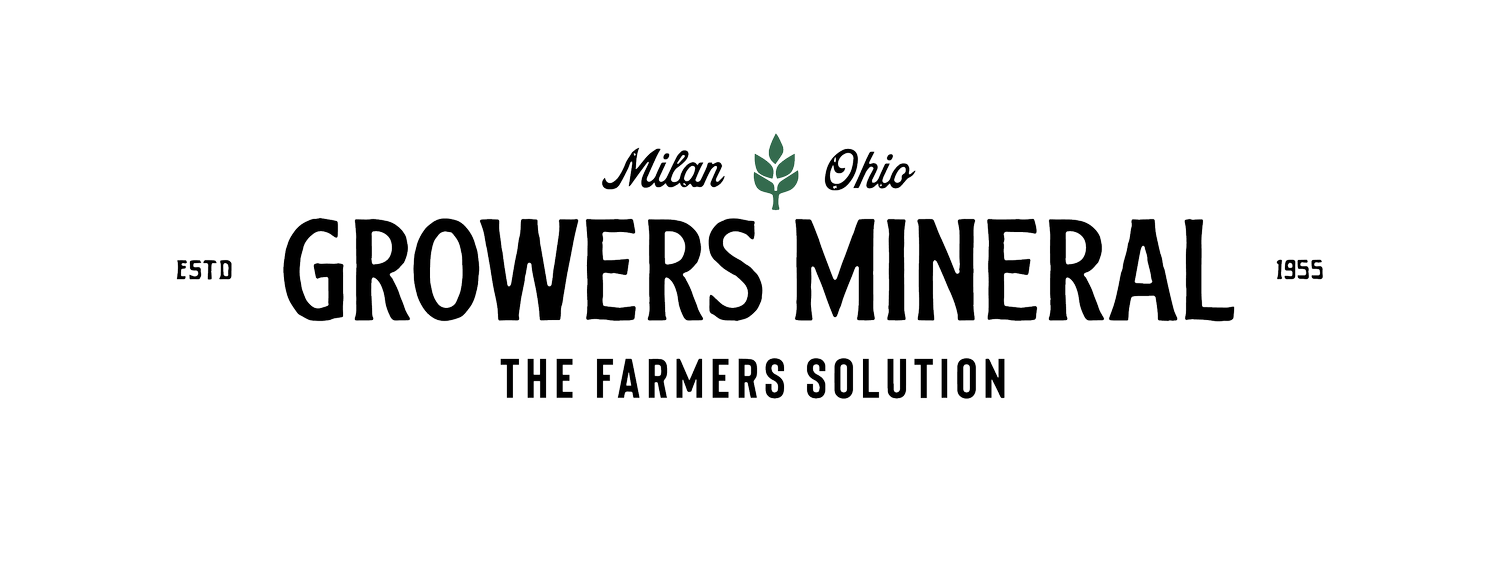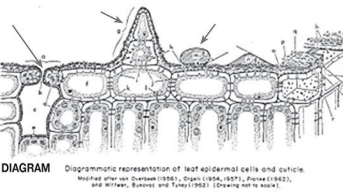Timing Foliage Feeding
The debate has raged for decades. What is the best time of day to foliage feed? So let's examine some old and new thoughts to this question. When looking at the surface of a leaf (see diagram), one concludes that it makes sense that daytime spraying of GMS would be least effective. With the stoma (long arrow) closed to control moisture loss, the main avenue to absorb nutrition appears limited.
Diagrammatic representation of leaf epidermal cells and cuticle.
A further view shows the leaf hair and water droplet (short arrows). From my days of both running a greenhouse and farming with Dad 500 acres, I always stated that it was best to have some sort of dew or dampness on the leaf before spraying GMS as it would be further distributed on the leaf during the most stoma open part of the day.
I also was wary of spraying material on a dry leaf at the end of a low humidity, high heat, and sunny day, as I saw what a bad idea that was when doing foliage feeding experiments in my tomato greenhouse. But recently, I have been reflecting on this stance and it has come from several different directions. But what really has me thinking now that I want to share with you came from an experience one long-time customer shared with me last year.
Before you continue reading, please study the overview of the observation chart, and then return and keep reading.
So how does a high water demanding plant such as potatoes manage to find enough moisture to double the yield, especially when the farmer started his spraying cycle after wilt and yellowing were observed?
This result, combined with information from other sources, observations on various crops here on the farm, and oddly enough, a brain surgeon's observation, has made me realize how much more is going on here than first thought, and maybe a new understanding of why foliage feeding results vary in their results. Here is my running theory of how to make foliage feeding much more effective. See what you think!
First, quality water is a must for more constant results, but the material you are using must be not only soluble but re-soluble. GMS was the best foliage feeding material in all the liquid fertilizers I tested at re-solubilizing.
The potatoes were sprayed mostly into the evening. The higher spray rate per gallon would have done a good job regardless of wind or humidity conditions saturating the leaf's surface.
It is at this stage a couple of things will happen. If the evening was dry and stays that way overnight, then most of the water and the majority of the GMS would be absorbed into the leaves and distributed to the plant, especially to the seed as that would have priority over the roots at thus stage of maturity.
From lab research, we know GMS attracts biology and tends to draw moisture to it (more on that in the future), so any material left behind on the leaf surface will tend to draw airborne humidity.
Now here is what is new to this: When daybreak occurs and the sun first appears on the horizon, the spectrum of light is most complete. We know that when the early morning light strikes the eyes, it "charges" the mitochondria and resets it to take on another day.
Consider this: If the leaf is coated with nutrition-laden moisture, and when the sun strikes that leaf's surface, I suspect the biology that is on the leaf surface is "charged" by the full spectrum light of the early morning sun. This combination helps the plant overcome the lack of biological action from the plant's roots not engaged due to dry soil.
This natural process was sustained and enhanced due to the farmer's constant night sprays with a small amount of GMS.
So perhaps one will benefit from timing foliage sprays in such a way that they are present when the sun first comes. Spraying in the morning is often too late as the most biologically influential light from the sun is when it first breaks over the horizon. Anything else sprayed later in the morning is too late for the benefit of that effect!
You'll be hearing more from me as my research continues on the benefits of light, the kind of light, and how big a deal this is not only to plant life, but to animals and us humans, too.
This is an excerpt from the Summer Growers Solution (2025) written by Matthew Gooding.
Signup for our newsletter to stay in the loop


